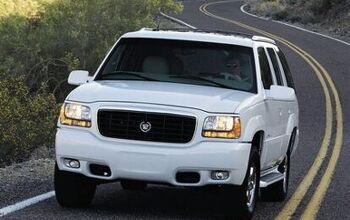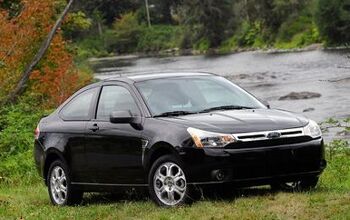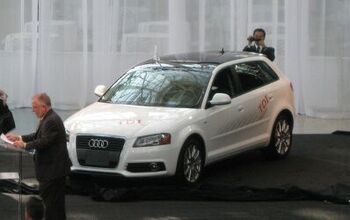The Truth About The Green Car of the Year
There’s something deliciously ironic about slogging through one of LA’s infamous rush hours to attend a “green” cars award ceremony. The multi-lane Harbor Freeway plays host to a long slow dance of cars and semis, tailpipes steadily churning out brownish plumes into a blue sky. The dominant hue is not green but red: the omnipresent brake lights mocking California’s long-abandoned promises of fast, efficient personal travel. It’s almost enough to persuade a driver to ride the bus. Like me, most just crank on caffeine and escape boredom via the stereo, instead.
Safely ensconced within the confines of the Convention Center, road rage gives way to the journalistic trough [fair disclosure] and a wander amongst enough exotic metal to give a 49er a heart attack. In my dreams, I can grab a fast steed from the floor and point it at a winding road and go. In reality, manufacturers employ Swiffer-wielding minions to dust the untouchables.
Anyway, back to this business of saving the planet. This year’s auto show has been transformed into an overhead cam version of Earth Day. Even our press room sponsor proclaims that it’s now “dedicated to a green future.” In past years, such unbridled vehicular earth worship from a tire manufacturer would be about as credible as Vogue promoting a positive body image to a bulimic support group. Today, auto industry types don’t as much play the green card as staple it to their forehead.
The third annual Green Car of the Year award comes courtesy of the Green Car Journal™; which is also the Green Car Journal Online™, GreenCar.com™, GreenCars.com™ and Green Car Online.com™. Whether or not Ron Cogan practices the TM that he preaches, the editor and publisher behind these ventures has fully grasped the marketing possibilities of cleaning-up the image of the [once and future] planet destroyer. Clearly.
If you were expecting a sneering panel of hippy judges drenched in patchouli and incense, think again. In addition to such green luminaries as Jean-Michel Cousteau (eldest son of Jacques, the original Fish Whisperer) and Sierra Club executive director Carl Pope, both Jay Leno and Carroll Shelby voted in this year’s eco-electoral college. Not that the (former) champions of unbridled horsepower bothered showing up. Still, had they attended, the erstwhile eco-converts would have been flattered (not to say intoxicated) by the substantial media presence.
Mr. Cogan’s buff book has yet to find an alternative fuel that it doesn’t like. This year’s five nominees amped-up the hybrid hype, but good. GM dominated the entries, with its hybrid versions of the Aura, Malibu and Tahoe. Hybrid variants of the Mazda Tribute and Nissan Altima completed the list of contenders.
The esteemed panel awarded the coveted prize to the Chevrolet Tahoe. Mr. Cogan burnished its halo with all the enthusiasm you’d expect from a man who jets around the world on someone else’s nickel to test “green” cars without disclosing the manufacturers’ contribution to his reports or carbon footprint.
The cynicism is warranted. The powerplant installed in this belle of the enviro-ball Tahoe hybrid begins with a 6.0-liter V8. GM opted to graft its hybrid system onto a motor that’s substantially larger (e.g. thirstier) than either the 4.8 or 5.3-liter conventional motors used in other Tahoes. Attach 400 pounds of batteries to this mammoth mill, and the resulting ecotank offers no improvement in highway fuel economy and slightly less towing capacity over the old-fashioned dino burner.
Employing a gasser 25 percent larger than the norm– instead of deploying a lighter motor of smaller displacement– only to weigh it down with nickel metal hydride, seems a lot more mean than green. Yet with battery acid on tap, apparently all is forgiven.
To be fair, not all of the runners-up deserve a slam. Both the Nissan Altima Hybrid and the Mazda Tribute Hybrid accomplish their missions: delivering relatively low emissions and strong fuel economy relative to their respective classes. If you want four-wheeled fodder for a general rant against gasoline-battery marriages, you won’t find it here.
Still, there’s no getting around it: this award is meant to be about “moving the bar forward” in the noble pursuit of slicing America’s overall fuel consumption through consumer choice. Unfortunately, the prize has delivered a less laudable lesson: how ecology-as-pop-culture can produce sub-optimal results.
The recurring theme of the awards presentation: sacrifice is wholly unnecessary. But the belief that one can pilot a big block V8 for a grocery run while doing the planet a favor is just as absurd as it sounds. Irrespective of where you shake out on matters environmental, the message of burn-it-big-but-with-batteries is overtly hypocritical, an idea worthy of a spin-crazed carmaker, not an [alleged] environmental crusader.
For the majority of those with a desire to save fuel, swapping your ride for a smaller car remains the obvious and most effective solution.
More by Adrian Imonti
Latest Car Reviews
Read moreLatest Product Reviews
Read moreRecent Comments
- Varezhka Maybe the volume was not big enough to really matter anyways, but losing a “passenger car” for a mostly “light truck” line-up should help Subaru with their CAFE numbers too.
- Varezhka For this category my car of choice would be the CX-50. But between the two cars listed I’d select the RAV4 over CR-V. I’ve always preferred NA over small turbos and for hybrids THS’ longer history shows in its refinement.
- AZFelix I would suggest a variation on the 'fcuk, marry, kill' game using 'track, buy, lease' with three similar automotive selections.
- Formula m For the gas versions I like the Honda CRV. Haven’t driven the hybrids yet.
- SCE to AUX All that lift makes for an easy rollover of your $70k truck.


































Comments
Join the conversation